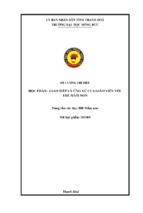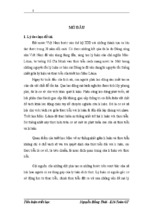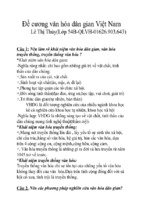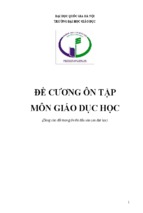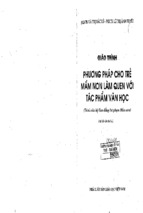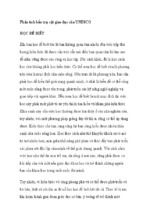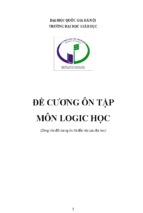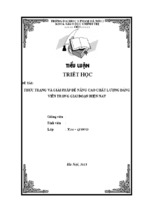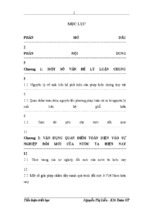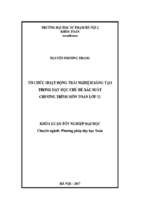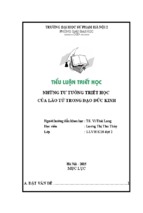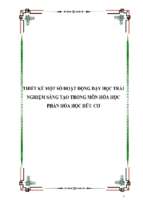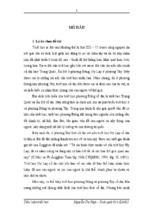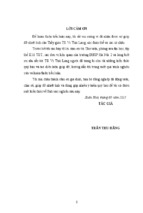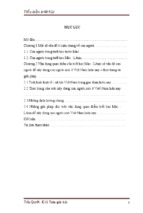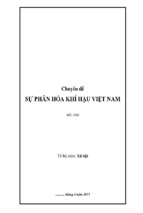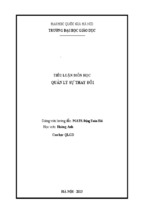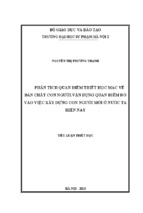THAI NGUYEN UNIVERSITY
SCHOOL OF FOREIGN LANGUAGES
NGUYEN THI HUYEN
APPLYING TOTAL PHYSICAL RESPONSE (TPR)
IN TEACHING ENGLISH VOCABULARY TO GRADE 5 STUDENTS
AT TRAN QUOC TOAN PRIMARY SCHOOL, BAC NINH PROVINCE
M.A. THESIS
Field: English Linguistics
Code: 8220201
THAI NGUYEN – 2020
THAI NGUYEN UNIVERSITY
SCHOOL OF FOREIGN LANGUAGES
NGUYEN THI HUYEN
APPLYING TOTAL PHYSICAL RESPONSE (TPR)
IN TEACHING ENGLISH VOCABULARY TO GRADE 5 STUDENTS
AT TRAN QUOC TOAN PRIMARY SCHOOL, BAC NINH PROVINCE
M.A. THESIS
Field: English Linguistics
Code: 8220201
THAI NGUYEN – 2020
ĐẠI HỌC THÁI NGUYÊN
TRƯỜNG NGOẠI NGỮ
NGUYỄN THỊ HUYỀN
ÁP DỤNG PHƯƠNG PHÁP PHẢN XẠ TOÀN THÂN
TRONG VIỆC DẠY TỪ VỰNG TIẾNG ANH CHO HỌC SINH LỚP 5
TẠI TRƯỜNG TIỂU HỌC TRẦN QUỐC TOẢN, TỈNH BẮC NINH
LUẬN VĂN THẠC SĨ
Ngành: Ngôn ngữ Anh
Mã số: 8220201
THAI NGUYEN – 2020
DECLARATION
I certify that the minor thesis entitled “Applying Total Physical Response
(TPR) in teaching English vocabulary to grade 5 students at Tran Quoc Toan
Primary School, Bac Ninh province” is my own study in the fulfillment of the
requirement for the Degree of Master of Arts at Foreign Language Faculty, Thai
Nguyen University.
Thai Nguyen, 2020.
Approved by Supervisor
Student
Dang Thi Thu Huong, PhD
Nguyen Thi Huyen
i
ACKNOWLEDGEMENTS
Thanks to the support of many people, this research has been completed. I
would like to start by expressing my great gratitude to my supervisor, Dr. Dang Thi
Thu Huong for her valuable comments, constant support and encouragement.
I also want to give my special thanks to teachers and grade 5 students of Tran
Quoc Toan Primary School for their supports in my experiment and response to my
survey questionnaires.
Finally, I am truly grateful to my family for their wholehearted care and
supporting me during the time I conducted the research and encouraging me all the
time when I encountered difficulties in completing the thesis.
ii
ABSTRACT
This study was conducted to explore the application of Total Physical
Response (TPR) method in teaching English vocabulary for grade 5 students at Tran
Quoc Toan Primary School, Bac Ninh province. The thesis began with literature
review on vocabulary teaching and TRP approach. Then quasi-experimental design
was applied to find out the improvement of students in retaining vocabulary by
using TPR method. A questionnaire was employed to 50 grade 5 students at Tran
Quoc Toan Primary School after tests and lessons with and without applying TPR
method to explore the benefits and difficulties of students in learning vocabulary
with TPR. The findings of the research show that TPR method has been used in
many subjects, and it is also applicable and effective to teach English vocabulary.
Therefore, the method was suggested to be exploited more in the context of
teaching vocabulary for grade 5 students at Tran Quoc Toan Primary School, Bac
Ninh province.
iii
TABLE OF CONTENT
DECLARATION ........................................................................................................ i
ACKNOWLEDGEMENTS ....................................................................................... ii
ABSTRACT .............................................................................................................. iii
TABLE OF CONTENT ............................................................................................ iv
LISTS OF TABLES ................................................................................................. vii
LIST OF FIGURES AND ABBREVIATIONS...................................................... viii
CHAPTER I: INTRODUCTION ................................................................................1
1.1. Rationale of the study .......................................................................................1
1.2. Aims of the study ..............................................................................................3
1.3. Scope of the study .............................................................................................3
1.4. Significance of the study ..................................................................................3
1.5 Structure of the study .........................................................................................4
CHAPTER II: LITERATURE REVIEW ...................................................................5
2.1. Vocabulary and vocabulary learning and teaching ...........................................5
2.1.1. Definitions of vocabulary ...........................................................................5
2.1.2. Learning vocabulary ...................................................................................8
2.1.3. Teaching vocabulary ..................................................................................9
2.1.4. Difficulty of teaching and learning vocabulary........................................10
2.1.5. Vocabulary retention ................................................................................11
2.2. Total Physical Response (TPR) ......................................................................12
2.2.1. Definitions of TPR ...................................................................................12
2.2.2. The characteristics of TPR .......................................................................14
2.2.3. The procedure of vocabulary teaching using TPR ...................................15
2.2.4. The Design of TPR ...................................................................................17
2.2.5 Techniques of TPR ....................................................................................19
2.2.6. Variations of TPR .....................................................................................21
2. 2.7. The Advantages of TPR ..........................................................................23
iv
2.2.8. The Disadvantages of TPR .......................................................................23
2.3 Overview of previous studies ..........................................................................24
CHAPTER III: METHODOLOGY ..........................................................................25
3.1. Research questions ..........................................................................................25
3.2. Research Methods ...........................................................................................25
3.3. Participants......................................................................................................26
3.4. Data collection ................................................................................................27
3.4.1. Data collection instruments ......................................................................27
3.4.2. Data collection procedure ............................................................................31
3.5. Data analysis ...................................................................................................34
3.5.1. Test result analysis ...................................................................................34
3.5.2. Questionnaire analysis ..............................................................................35
CHAPTER IV: FINDING AND DISCUSSION ......................................................36
4.1. Test analysis ....................................................................................................36
4.1.1. The students’ pre-test scores of the experimental and control group. .........36
4.1.2. The students’ scores in post – test 1 ............................................................38
4.1.3. The students’ scores in post – test 2 ............................................................40
4.2 Questionnaire result analysis ...........................................................................43
4.3. Discussion .......................................................................................................45
CHAPTER V: IMPLICATIONS AND CONCLUSION ..........................................47
5.1. Conclusion ......................................................................................................48
5.2. Implications ....................................................................................................49
5.3. Limitations of the study ..................................................................................49
REFERENCES ..........................................................................................................50
APPENDIXES ........................................................................................................... II
APPENDIX B: VOCABULARY TEST 2 (POSTTEST 1) ..................................... IV
APPENDIX C: VOCABULARY TEST 3 (POSTTEST 2) ....................................... V
APPENDIX D ......................................................................................................... VII
v
APPENDIX E........................................................................................................... IX
LESSON PLAN FOR THEME 2:............................................................................ XI
LESSON PLAN FOR THEME 3:.......................................................................... XIII
APPENDIX F .......................................................................................................... XV
APPENDIX G ..................................................................................................... XVIII
APPENDIX H ....................................................................................................... XXI
vi
LISTS OF TABLES
Table 3.1: Test description ....................................................................................... 28
Table 3.2: Questionnaire description ....................................................................... 30
Table 3.3: Procedure of training............................................................................... 33
Table 3.4: Conversion of percentage range ............................................................. 35
Table 4.1: Students’ scores of control group in pre-test .......................................... 36
Table 4.2: Students’ scores of experimental group in pre-test................................. 37
Table 4.3: Students’ scores of experimental group in post-test 1 ............................ 39
Table 4.4: Students’ scores of control group in post-test 1 ...................................... 40
Table 4.5: Students’ scores of experimental group in post-test 2 ............................ 42
Table 4.6: Students’ scores of control group in post-test 2 ...................................... 43
Table 4.7: Mean scores of two groups in vocabulary tests ...................................... 43
Table 4.8: Question 1 – Students’ opinions about TPR English lessons ................. 45
Table 4.9: Question 2 – Students’ opinions about TPR activities ........................... 46
Table 4.10: Question 3 – Interest in learning English vocabulary through TPR
activities ................................................................................................................... 47
vii
LIST OF FIGURES
Figure 2.1: TPR example 1 ...................................................................................... 13
Figure 2.2: TPR example 2 ...................................................................................... 14
Figure 2.3: Procedure for TPR ................................................................................. 17
Figure 2.4: Variations of TPR .................................................................................. 22
Figure 3.1: Illustration of Pretest – Posttest designs ................................................ 26
Figure 3.2: Data collection procedure ...................................................................... 31
Figure 4.1: The comparison between scores in post-test 1 of control and
experimental group. .................................................................................................. 41
Figure 4.2: Comparison between pre-test score and post-test 2 score of experimental
group......................................................................................................................... 44
LIST OF ABBREVIATIONS
%: Percent
TPR: Total Physical Response
CG: Control Group
EG: Experimental Group
viii
CHAPTER I: INTRODUCTION
In this chapter, the writer presents the rationale, objectives, scopes and the
structure of this study.
1.1. Rationale of the study
Currently, English has been widely used in Vietnam. This is a compulsory
subject in almost all school levels. Teaching English at primary schools is one of
the important goals concerned by the Government. In the article “The best age for
kids to learn a second language”, Laura Clark said that children aged from 6 to 13 is
the right time to learn another language along with their mother tongue because
children have a good memory to achieve new things during that period. In
particular, the 5th grade is the last class of primary education where students are
taught more vocabulary to improve communication. In addition, there is no
language without vocabulary and English is not an exception. That is the reason
why vocabulary is becoming one of the most important elements of language.
Vocabulary plays an important role in the process of learning English. Students
normally have difficulties in memorizing and mastering English vocabulary, so it is
difficult for them to comprehend both in spoken and written forms. In the Depth of
Processing Hypothesis, Craik and Tulving (1975) showed that “the more cognitive
energy a person exerts when manipulating and thinking about a word, the more
likely it is that they will be able to recall and use it later”. In other hand, Saleh
(1997:12) believed that, “[…] the success in mastering a language is determined by
the size of the vocabulary one has learned”. Learning new words relates to how we
understand them and how long we remember them. There were many factors
affecting word retention, for example, how diversification and frequently words
were used. According to Thornburg (2002: 23), “the learner needs not only to learn
a lot of words, but also to remember them”. Therefore, sensory memory has
important values in learning vocabulary.
In the past, teachers often used traditional methods to teach vocabulary such
as providing word explanations and requiring practices, however, that was not a
really effective method. According to Singer, A.J. (2003:39), “teaching is helping
1
learners to acquire new knowledge or skills. Teaching consisted, mainly, of telling,
showing, guiding the learner in performance tasks and then measuring the results”.
In some cases, some teachers do not have suitable methods to inspire their students
for learning English effectively, which makes students not excited to learn
vocabulary. It is easy to show that it is hard and challenging, and time-consuming.
Apart from grammar, vocabulary plays an essential role in learning languages,
English
particularly.
The
close
relationship
between
vocabulary
and
understandability must be expressed in the form of words. Finite vocabulary will
make learners find hard in communication, which loses their confidence and
gradually interests in studying English. Some reasons for those limitations may be
affected by teaching method, learning environment and motivation. Within the
scope of this study, teaching method will be focused on.
In primary education, vocabulary is considered one of the foundational
concerns in English teaching and learning. Thus, teachers should find effective
teaching methods to enhance students’ vocabulary so as to raise their interests and
language competency in learning English. So far, many researchers have provided
various methods to help students to easily study and memorize vocabulary. Of
them, TPR is regarded one of the most useful methods in teaching and learning
vocabulary.
In Tran Quoc Toan Primary School, English is a major subject. In teaching
vocabulary, the traditional technique – English-Vietnamese translation is mainly
used. The teachers also apply the Power Point Presentation with pictures in teaching
vocabulary, so the students only got passive from the teachers. They do not have
opportunities to practice vocabulary, therefore, their vocabulary memory is poor
and short-termed. So, it is necessary to apply an effective technique to improve
students’ vocabulary memory.
All the above-mentioned reason paved the way for the researcher to conduct
a study on using TPR approach to improve students’ vocabulary memory with an
expectation that will contribute to teaching and learning vocabulary for the teachers
at Tran Quoc Toan Primary School. The research aims to explore the influence and
2
effectiveness of applying TPR approach in teaching and learning vocabulary in
order to improve students’ retention of English vocabulary. Then, this research
targeted at introducing TPR as a technique to teach and learn vocabulary for grade 5
students at Tran Quoc Toan Primary School. The researcher also hopes that this
study would make a contribution to the development of language teaching and
learning vocabulary via TPR.
1.2. Aims of the study
The study aims at finding the effectiveness of using TPR method in
enhancing students’ English vocabulary at Tran Quoc Toan Primary School, Bac
Ninh province. Accordingly, the study found answers to the question:
-
What is effectiveness of TPR method in enhancing grade 5 students’ English
vocabulary?
1.3. Scope of the study
The study focuses on applying TPR in teaching English vocabulary for 50
students at grade 5, Tran Quoc Toan Primary School, Bac Ninh province. Due to
the fixed curriculum and limited time, the study will be carried out in the second
semester of school year 2019-2020.
1.4. Significance of the study
Essentially, the practical consideration of the research is the significance of
the expected research. Hence, the result of this study is expected to be useful to the
teachers, the students and the researcher in using TPR in teaching and learning
vocabulary.
The research is expected to explore and prove the effectiveness of applying
TPR method in teaching and learning English vocabulary. Therefore, teachers and
students at Tran Quoc Toan Primary School would conduct the teaching and
learning activities more effectively.
The researcher aspired that this study would give a contribution to the
development of language teaching and learning by applying TPR method for
English teachers at Tran Quoc Toan Primary School
3
This research was expected to eliminate the difficulties of students at Tran
Quoc Toan Primary School in retaining their vocabulary and it could help them to
improve their long-term memory and more interested in learning English,
specifically vocabulary.
For researchers, it is anticipated that this study would be one of the references
for other researchers to get information about teaching through TPR method.
1.5 Structure of the study
This study is divided into five chapters. They are:
Chapter I: “Introduction” – covers academic works required for research
paper, consists of rationale for the study, aims of the study, research questions,
scope of the study and organization of the study.
Chapter II: “Literature review” – provides the theoretical background of the
study, namely basic knowledge about English vocabulary and vocabulary teaching;
TPR in generally and in teaching and learning vocabulary.
Chapter III: “Methodology” – describes the methods used for this study,
data collection instruments, data collection procedures and data analysis procedure.
Chapter IV: “Finding and discussion” – presents, analyzes and discusses the
results collected. In this chapter, the answers for two research questions are found.
Chapter V: “Conclusion” – summarizes the main issues of this paper,
giving the limitations, pedagogical implications of the study and suggestions for
further studies.
4
CHAPTER II: LITERATURE REVIEW
This chapter gives an overview of vocabulary, vocabulary teaching and
learning, TPR method and using TPR in English teaching and learning.
Nowadays, there are many kinds of methods that can be used in teaching
English. The applied method needs not only to be interesting but also effective in
teaching languages. According to Harmer (2007), some students easily forget the
material because they are not active in learning process or deeply taking part in
learning process; if students and teacher don’t interact or response to each other,
learning in the class will be boring, no good atmosphere and environment to learn.
During the studying process, if the leaner only sit and listen to the teacher’s
explanation without involving their self or without any opportunities to take part in
learning process, it will make the students easily get bored.
After finding out the problems to be discussed, the researcher gives the
literature review of vocabulary, vocabulary learning and teaching, and Total
Physical Response method.
2.1. Vocabulary and vocabulary learning and teaching
2.1.1. Definitions of vocabulary
According to Meriam Webster, vocabulary is a list or collection of words or
phrase, usually alphabetically arranged and explained or defined.
Oxford (2018) defined vocabulary is a list of difficult or unfamiliar words
with an explanation of their meanings, accompanying a piece of specialist or foreign
language text.
Vocabulary is a set of familiar words within a person’s language. It usually
developed with age and serves as a useful and fundamental tool for communication
and acquiring knowledge.
Vocabulary is one of the most important elements, which supports for
developing four-language skills: listening, speaking, reading and writing.
“Vocabulary is the basic for the development of language”, As Hirai (2010: 50).
Furthermore, according to Cambridge Advance Learner’s Dictionary
Online, vocabulary is defined as
5
a) all the new words that a person knows or uses,
b) all the words that in a particular language,
c) the words that people use when they are talking about a particular subject
d) a lists of words with their meanings, especially in a book for learning a
foreign language.
The other definition of vocabulary states from Hatch and Brown (1995: 1),
they stated that vocabulary refers to a list or set of words for a particular language
or a list or set of words that individual speakers of language might use. Hatch and
Brown (1995:1) also state that vocabulary is the only system involved of
alphabetical order.
According to Kim and Kim (2012: 4), “vocabulary is the base of
communication in that language. Therefore, it is critical to try out various and
different teaching style that cheers students to acquire vocabulary easily without
negative emotion about it”. It is a element in forming sentences in order that
interactions among others can be happen fluently and the communication can easily
to understand. It is hard to communication without vocabulary, because the words
are used to express ideas, emotions and desires to each other. Shortly, vocabulary is
a tool for effective communication.
Based on those above statements, there are many definitions of vocabulary.
It can be assumed that vocabulary is a list of words as a basic component of
language proficiency which has own form or expression and consists of aspects,
they are meaning, use of word, form (pronunciation and spelling).
Hiebert and Kamil (2005: 3) divided word into two forms, the first is oral
vocabulary, which is the set of words for that the learners know the meanings when
they speak or read orally. The second is print vocabulary, which consists of those
words for which the meaning is known when learners write or read silently. They
also define knowledge of words also comes in at least two forms as follows:
a. Productive vocabulary: Productive vocabulary is the set of words that an
individual can use when writing or speaking. They are words that are renowned,
familiar, and used habitually.
6
b. Receptive or recognition vocabulary: Receptive or recognition
vocabulary is that set of words for which an individual can use for listening or
reading. These are words that are not as famous to students and routine in use as
productive vocabulary. Individuals may be able allocate some sort of meaning to
them, even though they may not know the full subtleties of the distinction.
Typically, these are also words that individuals do not use impromptu. However,
when individuals experience these words, they recognize them, even if imperfectly,
Besides, Thornbury (2002: 3-10) said that there are six kinds of vocabulary,
they are:
1) Word classes: Word classes or parts of speech. They are divided into
eight classes, such as: noun, pronouns, verb, adjective, adverb, preposition and
determiner.
2) Word families: It discusses about affixation of a word, such as: prefixes
(in-, de-) and suffixes (-tion, -ness).
3) Word formation: such as compounding, clipping, blending and so on.
Affixation is also a kind of word formation.
4) Multi-word units: about phrasal verbs and idioms
5) Collocations: Collocation is word partners. The typical collocation of
specific items is another factor that makes a particular mixture. Example: this week,
once more, once again, as well.
6) Homonyms: Kinds of vocabulary will be useful for students and teachers
in different situations in learning and teaching a language.
Furthermore, according to Richards (1976 cited in Ghazal, 2007) a word
requires knowing:
1) a great deal about its general frequency of use, syntactic and situation
limitation on its use
2) its underlying form and forms that can be derived from it
3) the network of its semantic features
4) the various meanings associated with the item.
7
Following Ur (1996) adapted in ELT Methodology II Course Book and
Recommended Readings (p.81-87), the main aspects of vocabulary are divided into:
a) form,
b) grammar,
c) aspects of meaning and
d) word building
So, knowing a word is not just ordinarily know its equivalent in one’s
mother tongue but there are a lot of aspects to cover. It makes difficult for teachers
and students in teaching and learning vocabulary.
Vocabulary becomes a major problem in learning English especially to the
first-year students, when they have good ability in mastering vocabulary, they will
be easier in memorize.
2.1.2. Learning vocabulary
Vocabulary learning plays an important part for people who learn English
both as foreign language and as second language. Ur (1994: 60) pointed out
vocabulary as the words we teach in the foreign language. In addition, Brown
(2001: 377) stated vocabulary items as a boring list of words that must be defined
and memorized by the students, lexical forms are seen in their central role in
contextualized, meaningful language. Richard in Schmitt (1997: 241) also stated
that knowing a word meaning knowing how often it occurs, the company it keeps,
its appropriateness in different situations, its syntactic behavior, its underlying form
and derivations, its word associations, and its semantic features. Tozcu and Coady
(2004: 473) viewed learning vocabulary is an important aspect of language two and
foreign language acquisition and academic achievement and is vital to reading
comprehension and proficiency, to which it is closely linked. Moreover, it is
asserted that vocabulary learning is based on the establishment of specific habits.
Since this involves the association of symbols and their meaning, it is clear that an
enrichment of the meaning of the word is as important as its frequent repetition.
Dunlap and Weisman (2007: 150) asserted, “vocabulary development is essential
for English learners’ academic success. There is a strong relationship between
8
vocabulary knowledge and academic achievement”. That is the reason why
vocabulary plays the main key in developing four language skills, it is very
important in teaching and learning language.
2.1.3. Teaching vocabulary
Teaching vocabulary is an important aspect of learning a language because
languages are based on words (Alqahtani, 2015). It is impossible to learn a language
without words; even communication between human beings is based on words.
Recent research indicates that teaching vocabulary may be problematic because
many teachers lack confident about the best practice in vocabulary teaching and
sometimes do not know where to start to focus on word learning (Berne &
Blachowicz, 2008). Either teachers or students agree that acquisition of the
vocabulary is a central factor in teaching a language (Walters, 2004). Teaching
vocabulary is considered as one of the most discussed parts of teaching English as a
foreign language. When the teaching and learning process takes place, problems
would appear to the teachers. They have problems of how to teach students in order
to obtain satisfying results. The teachers should be concerned that teaching
vocabulary is something new and different from student’s native language. They
also have to take into account that teaching English for young learners is different
from adults. The teacher should prepare and find out the appropriate techniques,
which will be implemented to the students.
According to McKeown and Beck (1988), direct vocabulary teaching is far
more effective than indirect ones. Mazano (2003) shows that the three most
important elements in a successful vocabulary teaching: motivating students to read
extensively the texts of the study field or other text of their choice. Direct teaching
of words or phrases related to student’s subjects; providing access for students to
get to know new words; and motivate students to more understand of the new words
by using real images, symbols, etc.
9
- Xem thêm -


